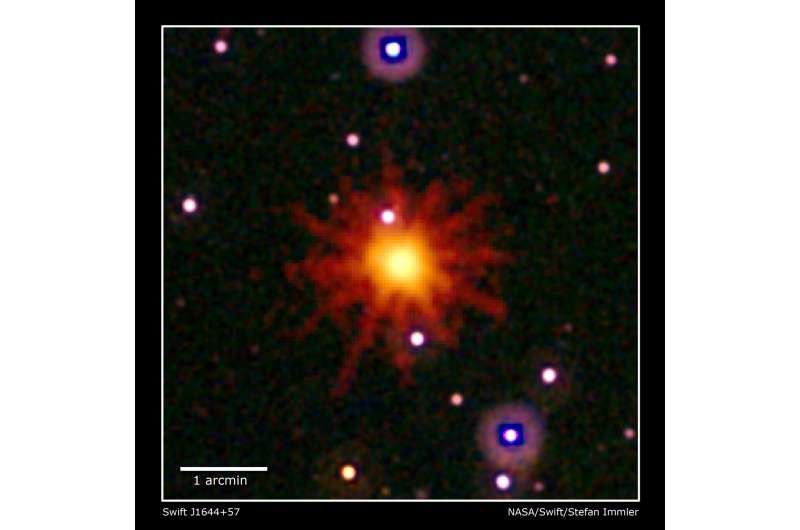August 23, 2021 report
Study explores short-term X-ray variability of the tidal disruption event Swift J1644+57

Using XMM-Newton and Swift space telescopes, Chinese astronomers have inspected short-term X-ray variability of a tidal disruption event known as Swift J1644+57. Results of the study, published August 12 on the arXiv pre-print server, yield important information regarding the properties of this TDE.
TDEs are astronomical phenomena that occur when a star passes close enough to a supermassive black hole and is pulled apart by the black hole's tidal forces, causing the process of disruption. Such tidally disrupted stellar debris starts raining down on the black hole and radiation emerges from the innermost region of accreting debris, which is an indicator of the presence of a TDE.
For astronomers and astrophysicists, TDEs are potentially important probes of strong gravity and accretion physics, providing answers about the formation and evolution of supermassive black holes.
Detected on March 28, 2011, Swift J1644+57 is a TDE that occurred in the center of a small galaxy in the Draco constellation, some 3.8 billion light years away. Although many studies of Swift J1644+57 have been conducted to date, it still puzzles astronomers due to its high X-ray brightness and peculiar variability.
Recently, a team of astronomers led by Chichuan Jin of the University of Chinese Academy of Sciences in Beijing, has investigated the long-term evolution of the short-term X-ray variability of Swift J1644+57. For this purpose, they employed NASA's Swift spacecraft and ESA's XMM-Newton satellite, aiming to shed more light on the event's X-ray flux distribution, power spectral density (PSD), root mean square (rms) variability, time lag and coherence spectra.
"The main idea of this work is to present the first exploratory study of the long-term evolution of various properties related to the short-term X-ray variability of TDEs. This type of study requires a series of deep follow-up observations on X-ray bright TDEs, although such datasets are rare. In this work, we mainly study the famous TDE Swift J1644+57, because this source was bright in X-rays and was observed by a series of deep XMM-Newton observations," the researchers explained.
According to the paper, the short-term X-ray flux of Swift J1644+57 in the normal state showcases the form of lognormal distribution, but deviates from this form significantly in its dipping state. Moreover, the source in the dipping state exhibited different low-frequency variability patterns, leading to much steeper PSDs and larger fractional rms amplitudes.
During the first XMM-Newton observations significant soft X-ray lags were detected with high coherences, which are about 50 seconds between 0.3-1 keV and 2-10 keV. However, no significant lag has been identified in later XMM-Newton observational data regardless of the event's flux states.
Furthermore, the study identified a potential long-term trend of PSD flattening, what points out to the contraction of the X-ray emission region. Using the 2-10 keV rms, the astronomers estimate that the black hole of Swift J1644+57 has a mass of around 0.6 to 7.9 million solar masses.
Summing up the results, the authors of the paper noted that their research adds new constraints on the X-ray mechanism of Swift J1644+57 and also demonstrates the great potential of conducting similar studies for new TDEs.
More information: Long-term Evolution of the Short-term X-ray Variability of the Jetted TDE Swift J1644+57, arXiv:2108.05593 [astro-ph.HE] arxiv.org/abs/2108.05593
© 2021 Science X Network





















